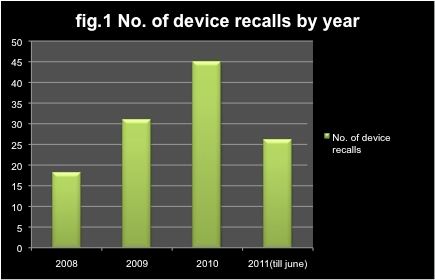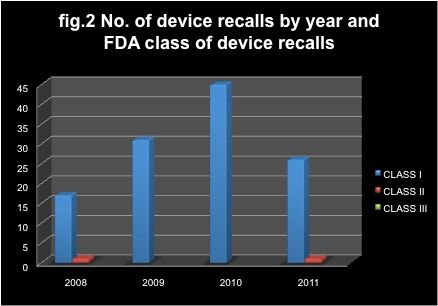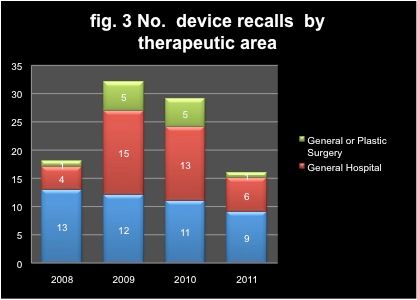Study of Medical Device Recalls by FDA Over Last Four Years (2008-2011)
The term “medical devices” includes everything from highly sophisticated computerized medical equipment down to simple wooden tongue depressors. The intended primary mode of action of a medical device on the human body, in contrast with that of medicinal products, is not metabolic, immunological, or pharmacological.
According to FDA, a medical device is, "an instrument, apparatus, implement, machine, contrivance, implant, in vitro reagent, or other similar or related article, including a component part, or accessory which is: recognized in the official National Formulary, or the United States Pharmacopoeia, or any supplement to them, intended for use in the diagnosis of disease or other conditions, or in the cure, mitigation, treatment, or prevention of disease, in man or other animals, or intended to affect the structure or any function of the body of man or other animals, and which does not achieve any of its primary intended purposes through chemical action within or on the body of man or other animals and which is not dependent upon being metabolized for the achievement of any of its primary intended purposes."
Materiovigilance can be defined as, “The monitoring of incidents or potential incidents that may result from the use of medical devices after their placing on the market.”
The purpose of materiovigilance is to study and follow incidents that might result from using medical devices. It enables dangerous devices to be withdrawn from the market and to eliminate faults in medical devices with the intention of constantly improving the quality of devices and providing patients and users with increased safety. Thus, Materiovigilance features include the reporting, recording, evaluating, and using information reported in a goal of prevention.
FDA's Center for Devices and Radiological Health (CDRH) is responsible for regulating firms who manufacture, repackage, relabel, and/or import medical devices sold in the United States.
In the United States, there are essentially two ways devices are reviewed before approval. A more rigorous process, known as premarket approval (PMA) involves reviewing evidence of clinical tests of a new device. A less stringent approach, known as the 510(k) process, is intended for the approval of devices that are similar to others already on the market. Once a device has been either approved or cleared by the Food and Drug Administration under one of these routes, it can be marketed.
After a device has been marketed, incidents in which a device may have caused or contributed to a death or serious injury must to be reported to FDA under the Medical Device Reporting program. The MDR regulation is a mechanism for FDA and manufacturers to identify and monitor significant adverse events involving medical devices. The goals of the regulation are to detect and correct problems in a timely manner.
Recalls occur when a medical device is defective, when it could be a risk to health, or when it is both defective and a risk to health. According to FDA, “recall is an action taken to address a problem with a medical device that violates FDA law.”
The FDA system classifies risk of harm from a device using three levels:
- a situation in which there is a reasonable probability that the use of, or exposure to, a product will cause serious adverse health consequences or death (FDA Class I);
- a situation in which the use of, or exposure to, a product may cause temporary or medically reversible adverse health consequences or where the probability of serious adverse health consequences is remote (FDA Class II);
- a situation in which the use of, or exposure to, a product is not likely to cause adverse health consequences (FDA Class III).
Methodology
The information that is publicly available on the FDA website was used to determine the number of devices which had been recalled over the period from January 2008 to June 2011. The information was then analzyed on how often the FDA issued high-risk recalls of medical devices.
The FDA website link was used to produce relevant information for each device on this high-risk recall list from 2008 through 2011.
It was also planned to determine the potential risk to patients associated with each of the recalled devices, using the system of classification employed by the FDA, the number of devices associated with each class per year were determined. The list of devices was also categorized according to their medical specialty (i.e., cardiovascular, general hospital, neurology or anesthesiology) as per given by FDA.
Individual medical device recall from the list was also studied thoroughly to find out the reason for recall of each device which was either manufacturing error or malfunctioning of device, microbial contamination or possibility of contamination, labeling error or regulation violation, or device giving incorrect answers. Then the devices were categorized in different groups on the basis of reasons of recall and the number of devices belonging to each group per year were analyzed.
Finally, the data was summarized by year, by FDA classification for recall, by medical specialty, and by reasons for recall, presenting data as raw counts, percentage, and in tabular and graphical form to analyze the results.
Results
In total, 121 names of recalled devices were included on FDA’s high-risk recall list, from January 2008 till June 2011. The data showed that the numbers of medical-device recalls increased by 250% over this period, from 18 in 2008 to 45 in 2010. The data from the year 2011 till June also shows the same result, and an increase in the number of medical device recalls will only grow as more recalls will be added to the list until the end of the year (Table.1, fig.1).
YEAR
NO. OF DEVICE RECALLS
2008
18
2009
31
2010
45
2011
27(till June 2011)
TOTAL
121

Of these 121 recalls, the FDA designated 119 as Class I recalls, which the FDA defines as the highest risk. Only two recalls belonging to th Class II recall category, one in 2008 and one in 2011, were there (Table.2, fig.2).
YEAR
NO. OF DEVICE RECALLS
CLASS I (%)
CLASS II (%)
CLASS III (%)
2008
18
17 (94)
1 (6)
-
2009
31
31 (100)
-
-
2010
45
45 (100)
-
-
2011
27 (till June 2011)
26 (96)
1 (4)
-
TOTAL
121
119 (98)
2 (2)

FDA has classified and described over 1,700 distinct types of devices and organized them in the CFR into 16 medical specialty "panels." Of these, the recalls were most concentrated in the cardiovascular area, with 35 separate recalls accounting for 29% of devices on the FDA’s high-risk recall list (fig.3). All of these recalled devices were used for treating cardiovascular disease. Most were automated external defibrillators (AEDs) approved for resuscitation of patients in cardiac arrest and catheters. The second largest high-risk recall category (23% of the total) was made up of 28 general hospital devices, including insulin pumps, intravenous infusion devices, and CO2 detectors etc.
Devices belonging to general or plastic surgery category showed the third highest, number 12, accounting for 10% of total device recalls. The rest of the devices belonged to various categories like neurology, anesthesiology, chemistry, microbiology, etc. There has been a decrease in cardiovascular device recalls over the period from 2008 to 2010.

Fig.4 shows the number of recalls due to various reasons. Most recalls were either due to manufacturing error or malfunctioning of the device. Device recalls due to manufacturing error comprises the largest category accounting for 45% (54 in number) of the total recalls each year, except in 2009 when recalls due to manufacturing error were highest. The second highest category comprises of recalls due to malfunctioning of device which showed 35 device recalls, that is, 29% of the total recalls. The third reason for device recall was microbial contamination, or possibility of contamination, to which there were 13 (11%) device recalls. Some of the recalls were also due to incorrect results displayed by the device.
A total of three device recalls were reported due to regulation violation, two in the year 2008 and one in 2010, and two recalls were also reported due to labeling error in 2008. The remaining six recalls were due to other reasons including recalls due to adverse events.

Discussion
The present analysis demonstrates a substantial increase in the number of medical device recalls issued from 2008 till 2011. FDA designated 119 of 121 recalls as Class I recalls, which the FDA defines as the highest risk recalls. Most of them were cardiovascular devices followed by devices belonging to general hospital category. There were various reasons for device recalls, but the manufacturing error and malfunctioning of devices accounted for the highest number of recalls. There were also other reasons for recalls of which we found three device recalls were due to regulation violation and two recalls were because of labeling errors. The regulation violation and labeling error was found only in 2008. Almost similar findings were found in previous studies conducted.
Conclusion
It can be concluded from the study that FDA plays an important role in vigilance of medical devices. The number of medical device recalls have increased over the last few years and the same trend is continuing. Almost all the devices belong to a high risk recall class, and the majority of recalled devices were cardiovascular devices.
Most medical devices recalled for life threatening or very serious hazards were originally cleared for market using the less stringent 510(k) process or were considered so low risk that they were exempt from review. These findings suggest that reform of the regulatory process is needed to ensure the safety of medical devices.
Given the ubiquity and variety of medical devices in modern healthcare, it is inevitable that a proportion will fail to perform as expected, or even cause harm. What seems unacceptable is increasing number of medical device recalls and a system of regulatory approval for devices that lacks even a basic level of transparency for independent evaluation.
Compared with the United States, India is lacking in specific regulations for medical devices and there is an urgent need to implement stringent government regulations concerning medical devices.
Nitin Nagreha, MD is a Lecturer at Clinical Research at Institute of Clinical Research India, e-mail: drnitinnagrecha@rediffmail.com, and Meeta Parmar is Regulatory Executive, B&S Healthcare, UK, e-mail: meeta_parmar@yahoo.co.in.
How Digital Technology and Remote Assessment Strategies Can Aid Clinical Trial Research
July 24th 2020While there's been hopeful news on treatments and vaccines, sponsors should plan to discuss necessary strategies and contingencies at the outset of new studies or re-opening of halted studies during the COVID-19 pandemic.